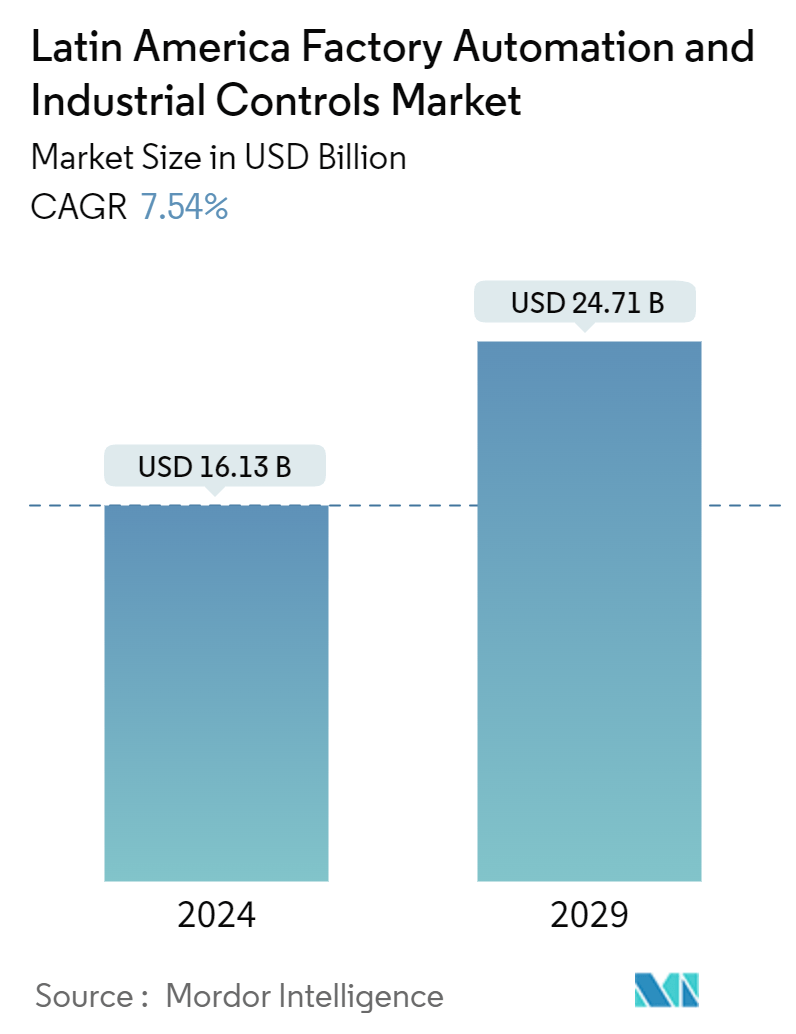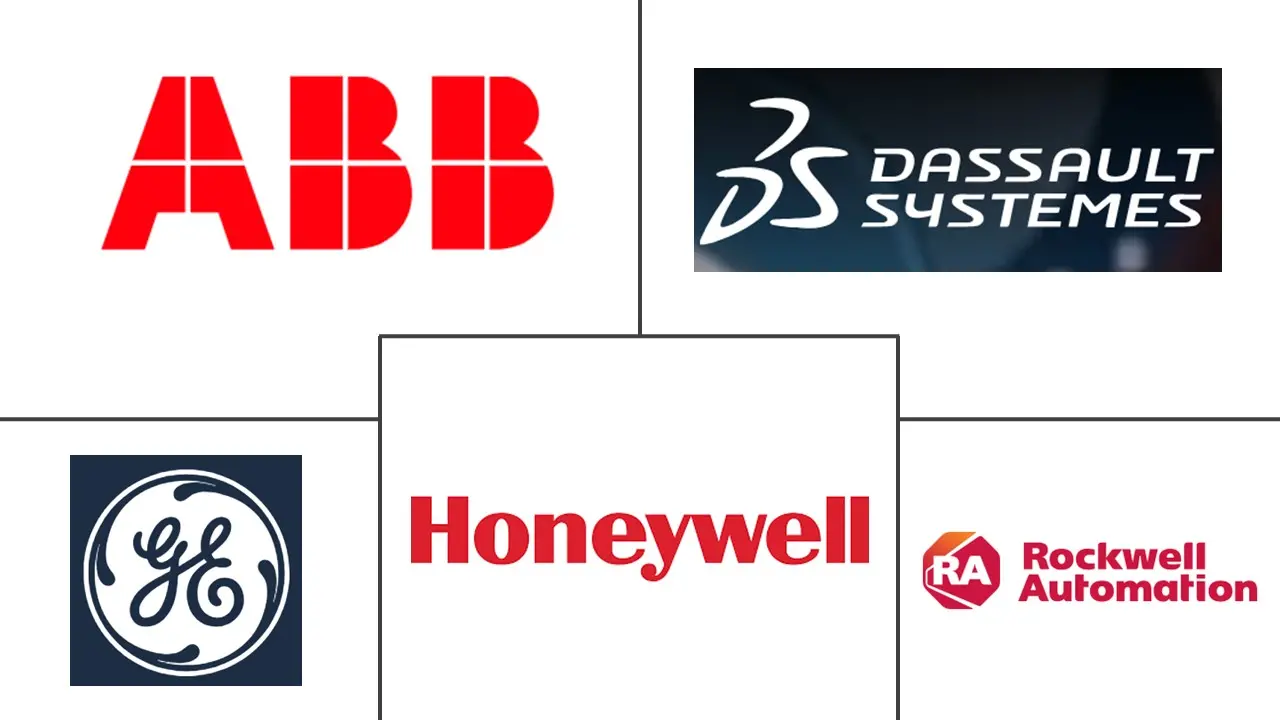Market Size of Latin America Factory Automation And Industrial Controls Industry

| Study Period | 2019 - 2029 |
| Base Year For Estimation | 2023 |
| Market Size (2024) | USD 16.13 Billion |
| Market Size (2029) | USD 24.71 Billion |
| CAGR (2024 - 2029) | 7.54 % |
| Market Concentration | Low |
Major Players
*Disclaimer: Major Players sorted in no particular order |
Latin America Factory Automation And Industrial Controls Market Analysis
The Latin America Factory Automation And Industrial Controls Market size is estimated at USD 16.13 billion in 2024, and is expected to reach USD 24.71 billion by 2029, growing at a CAGR of 7.54% during the forecast period (2024-2029).
- Factory automation and control solutions facilitate the automation of entire manufacturing/production facilities by designing and building fully integrated intelligent control systems, including robots, sensors, industrial equipment, computers, and advanced data processing solutions. Applying industrial automation technology allows production lines to run more efficiently and reliably, allowing products to be manufactured quickly to meet customer expectations. This is expected to fuel the adoption of factory automation and industrial control solutions in all the end-user verticals in Latin America, supported by industrialization growth, during the forecast period.
- Factors driving the market include the growing demand for adopting the Internet of Things (IoT) and machine-to-machine technologies. Also, incremental technological advancement, coupled with a sustained increase in the development of manufacturing facilities, is expected to impact the market growth rate during the forecast period. The increasing adoption of IoT in Latin America can be attributed to factors like rapid digitalization, technological advancements, government initiatives, policies, and investments aimed at promoting digital transformation and Industry 4.0., which support market growth.
- Factory automation can aid manufacturing organizations in decreasing costs by eliminating waste, reducing errors, and enhancing efficiency. By automating routine tasks, manufacturers can save time and lessen the cost of labor-intensive manual processes. Due to automation, manufacturers can make better use of their resources. Automated systems can handle tasks like material handling, inventory management, etc., reducing the need for employees to complete these tasks manually. This can free up resources like labor, time, and equipment for other more critical tasks. Also, by avoiding overstocking or stockouts, factories can reduce carrying costs, inventory holding costs, and the risk of obsolete inventory.
- The lack of skilled workforce in Latin America can be attributed to several factors. Inadequate access to quality education and training programs hinders the development of a skilled workforce. Limited resources, an outdated curriculum, and a lack of emphasis on practical skills contribute to a shortage of skilled professionals in the region. This is expected to hinder the market's growth.
- The COVID-19 pandemic forced manufacturing industries to re-evaluate their traditional production processes, primarily driving digital transformation and smart manufacturing practices across production lines. Manufacturers must also devise and implement multiple new and agile approaches to monitor product and quality control, which would fuel market growth.
Latin America Factory Automation And Industrial Controls Industry Segmentation
Factory automation refers to the use of control systems, machinery, and computer systems to automate industrial processes and tasks, reducing the need for human intervention. This includes processes like manufacturing, material handling, and quality control. Industrial controls encompass the products and systems used to monitor and control various industrial processes. This includes components like programmable logic controllers (PLCs), human-machine interfaces (HMIs), sensors, and software that manage and optimize the operation of machinery and equipment in industrial settings. These technologies and solutions are essential for improving efficiency, safety, and productivity in industrial operations.
The Latin American factory automation and industrial controls market is segmented by product type (industrial control systems (distributed control system (DCS), programmable logic controller (PLC), supervisory control and data acquisition (SCADA), product lifecycle management (PLM), human-machine interface (HMI), manufacturing execution system (MES), and enterprise resource planning (ERP)), field devices (machine vision, robotics (industrial), sensors and transmitters, motors and drives, and relays and switches)), end-user industry (oil and gas, chemical and petrochemical, power and utilities, food and beverages, automotive, and pharmaceutical), and country (Brazil, Argentina, Mexico, and Rest of Latin America). The market sizes and forecasts are provided in value terms (USD) for all the above segments.
| By Product Type | ||||||||||
| ||||||||||
|
| By End-user Industry | |
| Oil and Gas | |
| Chemical and Petrochemical | |
| Power and Utilities | |
| Food and Beverages | |
| Automotive | |
| Pharmaceutical | |
| Other End-user Industries |
| By Country | |
| Brazil | |
| Argentina | |
| Mexico | |
| Rest of Latin America |
Latin America Factory Automation And Industrial Controls Market Size Summary
The Latin America factory automation and industrial controls market is poised for substantial growth, driven by the increasing adoption of IoT and machine-to-machine technologies. This market is characterized by the integration of advanced control systems, including robots, sensors, and data processing solutions, which enhance manufacturing efficiency and reduce costs. The automotive industry, a significant sector in this region, is rapidly adopting automation to improve supply chain efficiency and productivity. The shift towards electric vehicles further propels the demand for automated manufacturing processes. However, the market faces challenges such as a shortage of skilled workforce due to inadequate educational resources and training programs, which could impede growth.
Brazil stands out as a key player in the region, with its robust manufacturing sector and significant adoption of industrial robots, particularly in the automotive industry. The country's oil and gas sector also presents opportunities for market expansion, supported by increasing production and consumption. The implementation of Industry 4.0 principles and IoT technologies is driving the need for smarter and more agile manufacturing processes. Major industry players like Rockwell Automation, ABB, and Honeywell are actively enhancing their product offerings through strategic partnerships and technological innovations, such as Rockwell's collaboration with Avid Solutions for Green Hydrogen production. These developments underscore the market's potential for growth and the ongoing transformation towards automated and connected industrial environments.
Latin America Factory Automation And Industrial Controls Market Size - Table of Contents
-
1. MARKET INSIGHTS
-
1.1 Market Overview
-
1.2 Industry Value Chain Analysis
-
1.3 Industry Attractiveness - Porter's Five Forces Analysis
-
1.3.1 Bargaining Power of Suppliers
-
1.3.2 Bargaining Power of Buyers
-
1.3.3 Threat of New Entrants
-
1.3.4 Threat of Substitute Products
-
1.3.5 Intensity of Competitive Rivalry
-
-
1.4 Assessment of the Impact of Macro Economic Factors and COVID-19 on the Market
-
-
2. MARKET SEGMENTATION
-
2.1 By Product Type
-
2.1.1 Industrial Control Systems
-
2.1.1.1 Distributed Control System (DCS)
-
2.1.1.2 Programmable Logic Controller (PLC )
-
2.1.1.3 Supervisory Control and Data Acquisition (SCADA)
-
2.1.1.4 Product Lifecycle Management (PLM)
-
2.1.1.5 Human Machine Interface (HMI)
-
2.1.1.6 Manufacturing Execution System (MES)
-
2.1.1.7 Enterprise Resource Planning (ERP)
-
2.1.1.8 Other Industrial Control Systems
-
-
2.1.2 Field Devices
-
2.1.2.1 Machine Vision
-
2.1.2.2 Robotics (Industrial)
-
2.1.2.3 Sensors and Transmitters
-
2.1.2.4 Motors and Drives
-
2.1.2.5 Relays and Switches
-
2.1.2.6 Other Field Devices
-
-
-
2.2 By End-user Industry
-
2.2.1 Oil and Gas
-
2.2.2 Chemical and Petrochemical
-
2.2.3 Power and Utilities
-
2.2.4 Food and Beverages
-
2.2.5 Automotive
-
2.2.6 Pharmaceutical
-
2.2.7 Other End-user Industries
-
-
2.3 By Country
-
2.3.1 Brazil
-
2.3.2 Argentina
-
2.3.3 Mexico
-
2.3.4 Rest of Latin America
-
-
Latin America Factory Automation And Industrial Controls Market Size FAQs
How big is the Latin America Factory Automation And Industrial Controls Market?
The Latin America Factory Automation And Industrial Controls Market size is expected to reach USD 16.13 billion in 2024 and grow at a CAGR of 7.54% to reach USD 24.71 billion by 2029.
What is the current Latin America Factory Automation And Industrial Controls Market size?
In 2024, the Latin America Factory Automation And Industrial Controls Market size is expected to reach USD 16.13 billion.

